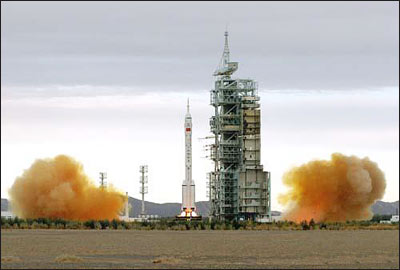In 1990, China had no modern science and technology at all -- fewer than 10 people in all China understood calculus. Now, in the early 21st century, the gap in high-technology research and development between China and the world's advanced countries has visibly shrunk; 60 percent of technologies, including atomic energy, space, high-energy physics, biology, computer, information technology and robot, have reached or are close to the world advanced level. The successful launches of manned spacecraft in 2003 and 2005 marked a leap in Chinese astronautics. According to the Moon Probe Project started in February 2004, China will launch unmanned probes to the moon before 2010, and gather moon soil samples before 2020.
China's development of science and technology and its system of granting scientific and technology awards are underpinned by the basic Law on Progress of Science and Technology promulgated in July 1993. The Law on Popularization of Science and Technology promulgated in June 2002 makes it a societal goal to popularize science and technology and knowledge among all citizens. Local regulations have been issued for attracting talented people, ensuring investment in science and technology, and developing high technology.
Since the 1990s, state budgets for science and technology and the R&D expenditure have greatly increased. In 2005, the appropriation for science and technology reached 109.53 billion yuan, 16 percent more than in 2004; expenditure on R&D rose to 236.7 billion yuan, 20.4 percent more than in 2004, and as a proportion of GDP was in the front rank among developing countries.
In 2004, there were 53.75 million scientific and technological personnel in state-owned enterprises and institutions, and out of every ten thousand employees 5,117 were scientific and technological personnel, compared with 870 in 1985. Some 54 percent of the academicians of the Chinese Academy of Engineering are scholars who have returned during the past dozen years after finishing their studies abroad.
From 2002, the national strategy for developing science and technology shifted from following on the heels of others to making independent innovations and technological strides, aiming at the international sci-tech heights. China is now in the world's advanced ranks in certain fields, attaining or approaching the front rank in some important scientific and strategic hi-tech fields. On February 9, 2006 the State Council issued the Guidelines on National Medium- and Long-Term Program for Science and Technology Development (2006-2020), which outlines a plan to speed up the pace of research on 16 special, key technologies in the coming 15 years, concerning such strategic industries as information industry and biology, important and urgent problems such as energy, resources, environment and health, and also R&D of large aircraft, manned space flight and moon probe project. By 2020, China's overall investment in research and development is expected to top 2.5 percent of GDP compared with 1.3 percent in 2005; the progress of science and technology will contribute 60 percent and above to the country's development; and the independent innovation capability, and comprehensive strength in studying basic science and frontier technology will be greatly improved -- these will build China into an innovative country.
 |

